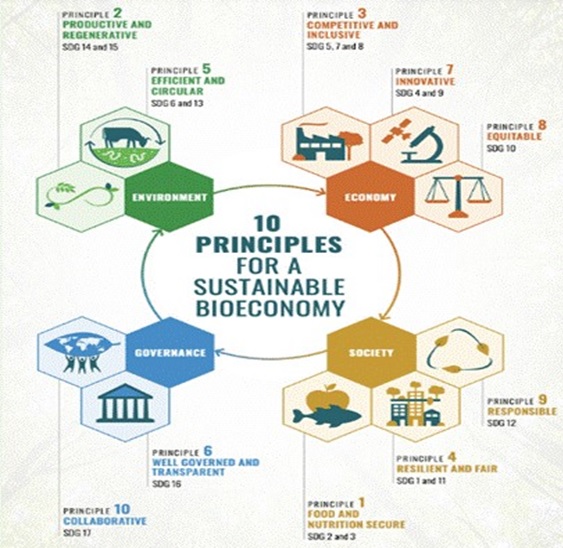| mains gs paper iii – Economy & Environment |
India is rapidly emerging as a “biotechnology powerhouse” of the 21st century. At the 2nd Foundation Day of the Biotechnology Research and Innovation Council (BRIC), the Union Minister of State for Science and Technology announced that India’s bioeconomy is projected to reach USD 300 billion in the coming years. On this occasion, plans for establishing a 200-acre BRIC–Bio-Enterprise Innovation Park in Faridabad were also unveiled.
BRIC was established in 2023 by merging 14 autonomous institutions under the Department of Biotechnology (DBT) to strengthen India’s biotech innovation ecosystem.

What is Bioeconomy?
Bioeconomy refers to an economic system that utilizes renewable biological resources — such as plants, animals, microorganisms, and bio-waste — to produce food, energy, industrial products, and services.
Main objectives:
- To reduce dependence on fossil fuels.
- To promote environmentally friendly and sustainable development.
- To create employment and balance rural–urban growth.
In short:
“Bioeconomy is a green economic framework built at the intersection of science, innovation, and sustainability.”
Current Status of India’s Bioeconomy
|
Year
|
Size of Bioeconomy
|
|
2014
|
USD 10 billion
|
|
2024
|
USD 165.7 billion
|
|
Target (2030)
|
USD 300 billion
|
- India’s bioeconomy has grown 16-fold in 10 years.
- The compound annual growth rate (CAGR) is about 17–18%.
- It contributes approximately 4.25% to India’s GDP (2024).
- Leading States (2024): Maharashtra (1st), Karnataka (2nd).
Major Initiatives Promoting India’s Bioeconomy
(a) BioE³ Policy (Economy, Environment & Employment) – 2024
- A new national policy approved by the Cabinet to promote high-performance bio-manufacturing.
- Aims to address the three “E” challenges — Economy, Environment, and Employment.
- Encourages green industries, innovation clusters, and start-ups.
(b) National Biopharma Mission (NBM) – Innovate in India (i3)
- Implemented by BIRAC (Biotechnology Industry Research Assistance Council).
- Supported by the World Bank with USD 250 million.
- Has aided 100+ projects and 30+ MSMEs in the biopharma sector.
About BIRAC:
- A not-for-profit company under Section 8 of the Companies Act, 2013.
- A Schedule-B Public Sector Enterprise under DBT.
- Acts as a bridge between research institutions, industry, and start-ups.
(c) Bioenergy Mission
- India achieved the E20 (20% ethanol blending) target five years ahead of schedule, in 2025 instead of 2030.
- This achievement reduces fossil-fuel dependence and enhances farmers’ income.
Four Major Sub-sectors of the Bioeconomy
|
Sub-sector
|
Approx. Share
|
Key Examples
|
|
Bio-industrial
|
47%
|
Biofuels, bioplastics, industrial enzymes
|
|
Bio-pharma
|
35%
|
Vaccines, biologics, medical devices
|
|
Bio-agriculture
|
8%
|
BT cotton, biofertilizers, precision farming
|
|
Bio-research
|
9%
|
Clinical trials, bioinformatics, biotech software
|
Significance of India’s Bioeconomy
- Environmental Protection: Reduction in carbon emissions and promotion of green industries.
- Employment Generation: Creation of millions of new jobs, especially in bio-manufacturing and bio-startups.
- Rural and Agricultural Empowerment: Bio-agriculture and biofuels enhance farmers’ income.
- Global Leadership: India ranks among the top countries in the Asia-Pacific in bioeconomy growth rate.
- Sustainable Development: Contributes to achieving SDGs 7, 9, 12, and 13 (Clean Energy, Industry-Innovation, Responsible Consumption, Climate Action).
Key Challenges
- Limited private-sector investment in research and innovation.
- Slow lab-to-market transition of technologies.
- Issues of bioresource conservation and regulation.
- Shortage of skilled manpower and specialized training.
- Policy disparities across states.
Way Forward
- Develop bio-clusters like the BRIC Bio-Innovation Park in every state.
- Increase R&D investment, especially with private-sector participation.
- Strengthen bio-policy and intellectual property (IP) frameworks to attract investment.
- Promote education and skill development in biotechnology, bioinformatics, and biomanufacturing.
- Foster international collaborations with countries such as the EU, USA, and Japan.
Conclusion
India’s bioeconomy is not just an economic domain but a foundation for a new green revolution. With balanced efforts in policy, research, and industrial collaboration, India can achieve its target of a USD 300 billion bioeconomy by 2030.




